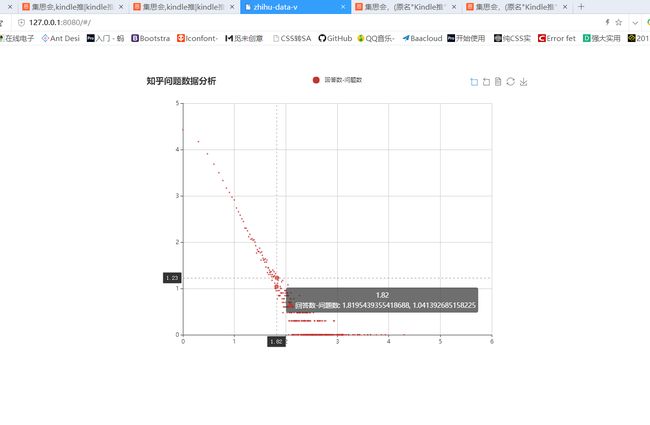前段时间看了一节公开课,教的是用node.js来爬知乎的数据。
下面会给出github地址,也会附上代码,简单记录一下自己踩过的坑。
https://github.com/zhangjing9898/crawler
这是爬问题的函数
async function getQuestion(db, id) {
let res = await rp({url: `https://www.zhihu.com/question/${id}`});
let $ = cheerio.load(res);
let data = $('#data').attr('data-state');
let state = JSON.parse(htmlDecode(data));
let question = state.entities.questions[id];
db.collection("questions")
.insert(question)
console.log(`question id : ${id} insert into db`)
await getAnswers(db, id, question.answerCount)
}
这是爬该问题的评论数
async function getAnswers(db, id, answerCount) {
for (let offset = 0; offset < answerCount; offset += 20) {
let res = await rp({
url: `https://www.zhihu.com/api/v4/questions/${id}/answers?sort_by=default&include=data%5B%2A%5D.is_normal%2Cadmin_closed_comment%2Creward_info%2Cis_collapsed%2Cannotation_action%2Cannotation_detail%2Ccollapse_reason%2Cis_sticky%2Ccollapsed_by%2Csuggest_edit%2Ccomment_count%2Ccan_comment%2Ccontent%2Ceditable_content%2Cvoteup_count%2Creshipment_settings%2Ccomment_permission%2Ccreated_time%2Cupdated_time%2Creview_info%2Crelevant_info%2Cquestion%2Cexcerpt%2Crelationship.is_authorized%2Cis_author%2Cvoting%2Cis_thanked%2Cis_nothelp%2Cupvoted_followees%3Bdata%5B%2A%5D.mark_infos%5B%2A%5D.url%3Bdata%5B%2A%5D.author.follower_count%2Cbadge%5B%3F%28type%3Dbest_answerer%29%5D.topics&limit=20&offset=${offset}`,
headers: {
authorization: "oauth c3cef7c66a1843f8b3a9e6a1e3160e20"
}
})
let data = JSON.parse(res);
let answers = data.data;
db.collection("answers").insertMany(answers);
}
}
这是main·函数:
async function main() {
let url = 'mongodb://localhost:27017/crawler';
let db = await MongoClient.connect(url);
for(let id=30000000;id<40000000;id++){
try {
await getQuestion(db,id);
}catch (err){
console.log(`question id : ${id}`);
}
}
//爬知乎数据,详细版:
// let url="mongodb://localhost:27017/crawler";
// let db=await MongoClient.connect(url);
//
// await Promise.map(
// [...range(start,end)],
// async i=>{
// try{
// await retry(async()=>{
// let question=await db.collection('questions').findOne({id:i});
// if(question){
// console.log(`question id:${i} already exists,skip`)
// }else{
// try {
// await Promise.resolve(getQuestion(db,i)).timeout(20000);
// }catch(err){
// if(err.name=='StatusCodeError'){
// return console.log(`question id:${i} StatusCodeError is ${err.statusCode}`)
// }
// console.log(`question id:${i} error occur,${err.name},retry......`);
// throw err;
// }
// }
// },{max_tries:10,interval:2000})
// }catch (err){
// console.log(`question id: ${i} retry fail,drop`)
// }
// },
// {concurrency:50} /*控制并发数*/
// )
}
main().catch(err => console.log(err))
数据爬出来了,下一步就是将它可视化展示,这里用到了echarts,其实用图表展示可以使用echarts或者d3,d3展示的图类更加丰富,同时难度大于echarts,所以这里用的vue-echarts,用了vue的脚手架来构建,下面会给出github地址。
坑:
1.vue的脚手架下 使用eslintrc规范,如果不想使用这种规范,可以在config目录下的index.js的useEslint: 设置为false。
2.在对数据库中的数据进行聚合已经分类等的时候,我用了mongovue中的aggravate。
下面来记录一哈步骤:
//stage 1
{
$group: {
_id: '$id',
visitCount: {$last: '$visitCount'},
topics: {$last: '$topics'},
answerCount: {$last: '$answerCount'},
created: {$last: '$created'},
updateTime: {$last: '$updateTime'},
commentCount: {$last: 'commentCount'},
followerCount: {$last: 'followerCount'}
}
},
//stage 2
{
$out: "d_questions"
},
选中collections 然后找到aggressive选项 然后把上面这一块paste上去 。它的意思就相当于mysql中的distinct+group by ,再把结果输出在d_questions这个collections里面。
{
$group: {
_id: '$answerCount',
count:{"$sum":1}
}
},
{
$out: "t"
},
同理 这一块的意思是 聚合分类 比如评论数为1的个数是5000条 评论数为60 的个数只有1 ,用于后面做词云图等等。
这是爬知乎数据做可视化分析的 github地址:https://github.com/zhangjing9898/zhihu-data-view
这是将数据可视化。
这里的chart都是echarts里面的
在后台如何分析数据,可以用到nodejieba这个库 可以将长句子或者文章进行分词操作 然后计算分析

